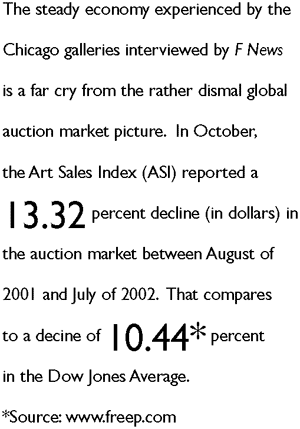

In the midst of the current economic recession, brought on
in large part by the events of September 11, 2001, museums and galleries around
the country have been faced with lower attendance, as well as a decline in the
sale of artwork. However, Chicago galleries have a positive outlook that has
only strengthened their role as significant and valuable representatives of
art in Chicago.
In the wake of economic insecurity, the Art Institute of Chicago
has enforced cutbacks in departments throughout the museum and the school. Galleries
owned and operated by SAIC are faced with challenging financial circumstances,
yet continue to provide rich environments for students to display their art
works.
The highly motivated workforce at the Betty Rymer Gallery
has classified themselves as creative problem-solvers in this new reality of
financial responsibility. Trevor Martin, senior administrator at the gallery,
tackles distinguishing the extras from the essentials. Sensibly, Martin has
chosen to organize five rather than six exhibitions this year in order to ensure
a fuller experience for both the showing artists and the spectators.
Other galleries such as FLATFILE Photography, located in the
West Loop Gate area, have not suffered any losses. Gallery director Susan Aurinko
has noticed as many or more appearances at openings, although fewer people have
been inclined to walk in on a casual basis. Aurinko asserts her gallery maintains
steady revenue because of the range in prices, beginning at very affordable,
particularly those works that are not sold off the wall.
The steady economy experienced by the Chicago galleries interviewed
by F News is a far cry from the rather dismal global auction market picture.
In October, the Art Sales Index (ASI) reported a 13.32 percent decline (in dollars)
in the auction market between August of 2001 and July of 2002. The report noted
that the decline is a by-product of both a decrease in the number of artworks
sold as well as the weakening of average prices on auctioned art. The results
cover some 75 percent of the world auction market. The Art Newspaper reported
that the art market has been heavily affected by the post-September 11 collapsing
stock market and high international tensions.
Still, Chicago galleries paint a more optimistic picture.
Apt. 1R, in the Pilsen gallery district, has also shown no reflection of economic
hardship. Gallery director Van Harrison claims that more art has been sold in
his gallery in recent months than ever. With a growing attendance and promising
profit, he plans to celebrate the gallery’s first year anniversary on
November 8 at a new location in the West Loop Gate area.
In the River North district, Zolla/ Lieberman shares an equally
positive point of view. Gallery manager Catherine Coykendall said, “Collectors
are slightly weary at this time, but a lot has to do with the artists shown.”
Zolla/ Lieberman hosted a nearly sold-out Deborah Butterfield show last month.
Coykendall remarked that “conceptual works fail to sell
as well in the Midwest,” where many are more conservative with their tastes.
And while the global art market continues to grapple with the economic downturn, Chicago’s small galleries barely flutter an eye at the ASI news. It seems each gallery offers a different reason for their budding public attendance and earnings, but nonetheless they all attest to the Chicago art community’s continuing prosperity and success, despite economic instability.